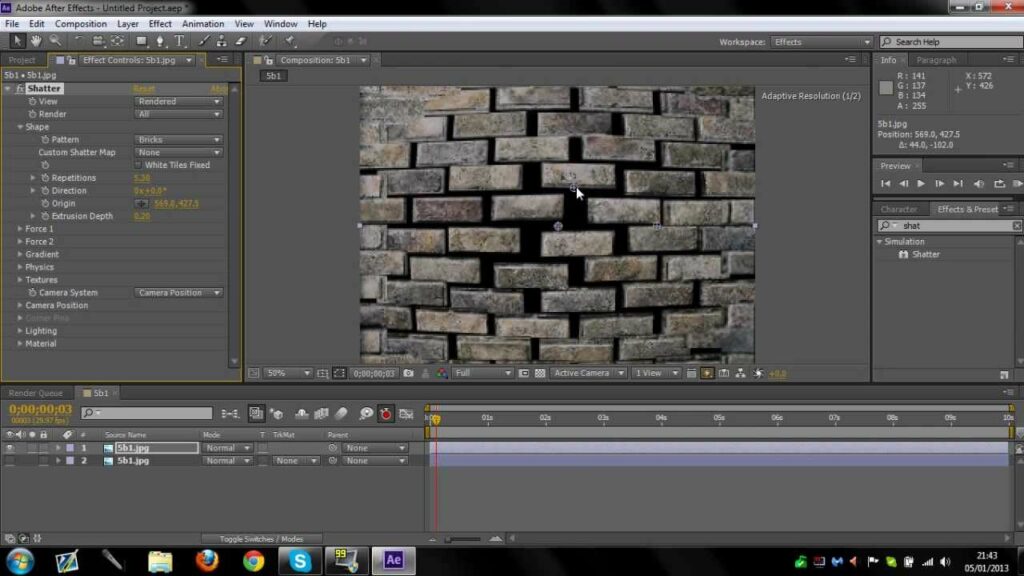Breaking Boundaries: A Comprehensive Guide to Mastering the Shatter Effect in Adobe After Effects

Introduction: The Shatter effect in Adobe After Effects is a powerful tool that allows artists to break apart layers and objects into dynamic fragments, creating explosive and visually stunning animations. Inspired by the concept of destruction and chaos, the Shatter effect offers endless possibilities for adding drama, excitement, and impact to motion graphics, title sequences, and visual effects. In this comprehensive guide, we’ll explore the intricacies of using the Shatter effect in After Effects, covering techniques for customization, animation, and advanced applications to unleash your creativity and bring your ideas to life.
Understanding the Shatter Effect: The Shatter effect in Adobe After Effects simulates the destruction or fragmentation of layers and objects by generating a series of dynamic shards or pieces. By defining parameters such as shape, force, and gravity, artists can control the appearance and behavior of the shattered elements, creating a wide range of visual effects, including explosions, impacts, and disintegrations. Whether used for creating dramatic transitions, dynamic text animations, or surreal visual compositions, the Shatter effect offers unparalleled flexibility and creative potential for crafting compelling animations.
Getting Started with the Shatter Effect: To begin using the Shatter effect in After Effects, follow these steps:
Step 1: Apply the Shatter Effect: Select the layer or object to which you want to apply the Shatter effect in the After Effects timeline. Navigate to the Effects & Presets panel and search for the “Shatter” effect. Apply the effect to your layer by dragging it onto the desired layer or by selecting the layer and double-clicking the effect in the panel.
Step 2: Customize the Shatter Settings: Once the Shatter effect is applied, you’ll have access to a variety of parameters for customizing its appearance and behavior. These parameters include:
- Pattern: Choose from a variety of preset patterns such as Glass, Bricks, or Blocks to define the shape and structure of the shattered elements.
- Force: Specify the force or energy applied to the shattering process, affecting the speed and direction of the fragments. Adjusting the force parameters allows you to control the intensity and impact of the shatter effect.
- Gravity: Define the strength and direction of gravity affecting the shattered elements. Use gravity settings to simulate the natural movement and behavior of falling debris or particles.
- Replica: Enable the Replica feature to create multiple copies or instances of the shattered elements, allowing for increased complexity and density in the animation.
- Physics: Fine-tune physics parameters such as Bounciness, Friction, and Air Resistance to control the behavior and interaction of the shattered elements with the environment.
Step 3: Animate the Shatter Effect: Animate the properties of the Shatter effect to bring your composition to life. Use keyframes to animate parameters such as force, gravity, and pattern over time. Experiment with different animation styles, timing, and easing to achieve dynamic and engaging motion effects.
Step 4: Customize Fragmentation and Debris: Customize the appearance of the shattered elements by adjusting parameters such as size, shape, and opacity. Use masks, textures, and blending modes to add depth, texture, and realism to the fragments. Experiment with different settings to achieve the desired look and style for your shatter animation.
Step 5: Fine-Tune and Preview: Fine-tune the settings of the Shatter effect and preview the animation to ensure that it meets your expectations. Adjust parameters such as pattern, force, and gravity to achieve the desired visual impact and realism. Preview the animation in real-time to identify any issues or areas for improvement.
Advanced Techniques and Tips: To take your shatter animations to the next level, consider exploring the following advanced techniques and tips:
- Custom Patterns and Masks: Create custom patterns and masks to define the shape and structure of the shattered elements. Use shape layers, text layers, or custom masks to create intricate patterns and designs for the shatter effect, adding complexity and visual interest to the animation.
- Texture Mapping and Materials: Apply texture mapping and material properties to the shattered elements to add realism and depth to the animation. Use textures, bump maps, and specular highlights to simulate the appearance of different materials such as glass, metal, or wood.
- Dynamic Lighting and Shadows: Incorporate dynamic lighting and shadows into your shatter animation to enhance realism and visual impact. Use lighting effects such as Spotlights or Point Lights to illuminate the shattered elements from different angles, casting realistic shadows and highlights.
- Interactive Controls and Expressions: Create interactive controls and expressions to dynamically control the behavior of the Shatter effect. Use expressions to link parameters such as force, gravity, and pattern to user-defined variables or sliders, allowing for real-time adjustments and experimentation.
- Integration with 3D Elements: Integrate the Shatter effect with 3D elements and scenes in After Effects to create seamless transitions and visual effects. Use 3D layers, cameras, and lights to composite the shattered elements within a 3D environment, adding depth and immersion to the animation.
Conclusion: The Shatter effect in Adobe After Effects offers a versatile and powerful tool for creating dynamic and visually stunning animations. Whether used for creating explosive effects, dramatic transitions, or surreal visual compositions, the Shatter effect provides endless possibilities for creative expression and experimentation.
As you embark on your journey to master the Shatter effect in After Effects, remember to embrace experimentation, iteration, and innovation. Explore new techniques, push the boundaries of your creativity, and let your imagination soar as you craft captivating animations that captivate and inspire. With dedication, practice, and a willingness to explore new possibilities, you’ll unlock the full potential of the Shatter effect and create animations that leave a lasting impression on your audience.




